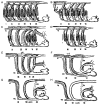Sensory innervation of the Gills: O2-sensitive chemoreceptors and mechanoreceptors
- PMID: 19193399
- PMCID: PMC2736790
- DOI: 10.1016/j.acthis.2008.11.002
Sensory innervation of the Gills: O2-sensitive chemoreceptors and mechanoreceptors
Abstract
Physical characteristics of water (O(2) solubility and capacitance) dictate that cardiovascular and ventilatory performance be controlled primarily by the need for oxygen uptake rather than carbon dioxide excretion, making O(2) receptors more important in fish than in terrestrial vertebrates. An understanding of the anatomy and physiology of mechanoreception and O(2) chemoreception in fishes is important, because water breathing is the primitive template upon which the forces of evolution have modified into the various cardioventilatory modalities we see in extant terrestrial species. Key to these changes are the O(2)-sensitive chemoreceptors and mechanoreceptors, their mechanisms and central pathways.
Figures





Similar articles
-
Ontogenesis of oxygen chemoreception in aquatic vertebrates.Respir Physiol Neurobiol. 2006 Nov;154(1-2):139-52. doi: 10.1016/j.resp.2006.01.004. Epub 2006 Feb 20. Respir Physiol Neurobiol. 2006. PMID: 16488670 Review.
-
Hypercarbic cardiorespiratory reflexes in the facultative air-breathing fish jeju (Hoplerythrinus unitaeniatus): the role of branchial CO2 chemoreceptors.J Exp Biol. 2010 Aug 15;213(Pt 16):2797-807. doi: 10.1242/jeb.040733. J Exp Biol. 2010. PMID: 20675550
-
Sensing and transfer of respiratory gases at the fish gill.J Exp Zool. 2002 Aug 1;293(3):249-63. doi: 10.1002/jez.10129. J Exp Zool. 2002. PMID: 12115900 Review.
-
Evolution of air-breathing and central CO(2)/H(+) respiratory chemosensitivity: new insights from an old fish?J Exp Biol. 2000 Nov;203(Pt 22):3505-12. doi: 10.1242/jeb.203.22.3505. J Exp Biol. 2000. PMID: 11044388
-
Respiratory control of acid-base status in lungfish.Comp Biochem Physiol A Mol Integr Physiol. 2019 Nov;237:110533. doi: 10.1016/j.cbpa.2019.110533. Epub 2019 Aug 6. Comp Biochem Physiol A Mol Integr Physiol. 2019. PMID: 31398391 Review.
Cited by
-
'Extreme' organisms and the problem of generalization: interpreting the Krogh principle.Hist Philos Life Sci. 2018 Oct 31;40(4):65. doi: 10.1007/s40656-018-0231-0. Hist Philos Life Sci. 2018. PMID: 30382416 Free PMC article.
-
Ventilatory responses of the clown knifefish, Chitala ornata, to arterial hypercapnia remain after gill denervation.J Comp Physiol B. 2019 Dec;189(6):673-683. doi: 10.1007/s00360-019-01236-6. Epub 2019 Sep 24. J Comp Physiol B. 2019. PMID: 31552490
-
Expression of the Antimicrobial Peptide Piscidin 1 and Neuropeptides in Fish Gill and Skin: A Potential Participation in Neuro-Immune Interaction.Mar Drugs. 2022 Feb 17;20(2):145. doi: 10.3390/md20020145. Mar Drugs. 2022. PMID: 35200674 Free PMC article. Review.
References
-
- Adriaensen D, Brouns I, Van Genechten J, Timmermans J-P. Functional morphology of pulmonary neuroepithelial bodies: extremely complex airway receptors. Anat Rec. 2003;270A:25–40. - PubMed
-
- Andresen MC, Kunze DL. Nucleus tractus solitarius – gateway to circulatory control. Annu Rev Physiol. 1994;56:93–116. - PubMed
-
- Ballintijn CM, Bamford OS. Proprioceptive motor control in fish respiration. J Exp Biol. 1975;62:99–114. - PubMed
-
- Bianchi AL, Denavit-Saube M, Champagnat J. Central control of breathing in mammals: neuronal circuitry, membrane properties and neurotransmitters. Physiol Rev. 1995;75:1–45. - PubMed
-
- Boyd JD. Nerve supply to the branchial arch arteries of vertebrates. J Anat Lond. 1936;71:157–158.
Publication types
MeSH terms
Substances
Grants and funding
LinkOut - more resources
Full Text Sources

